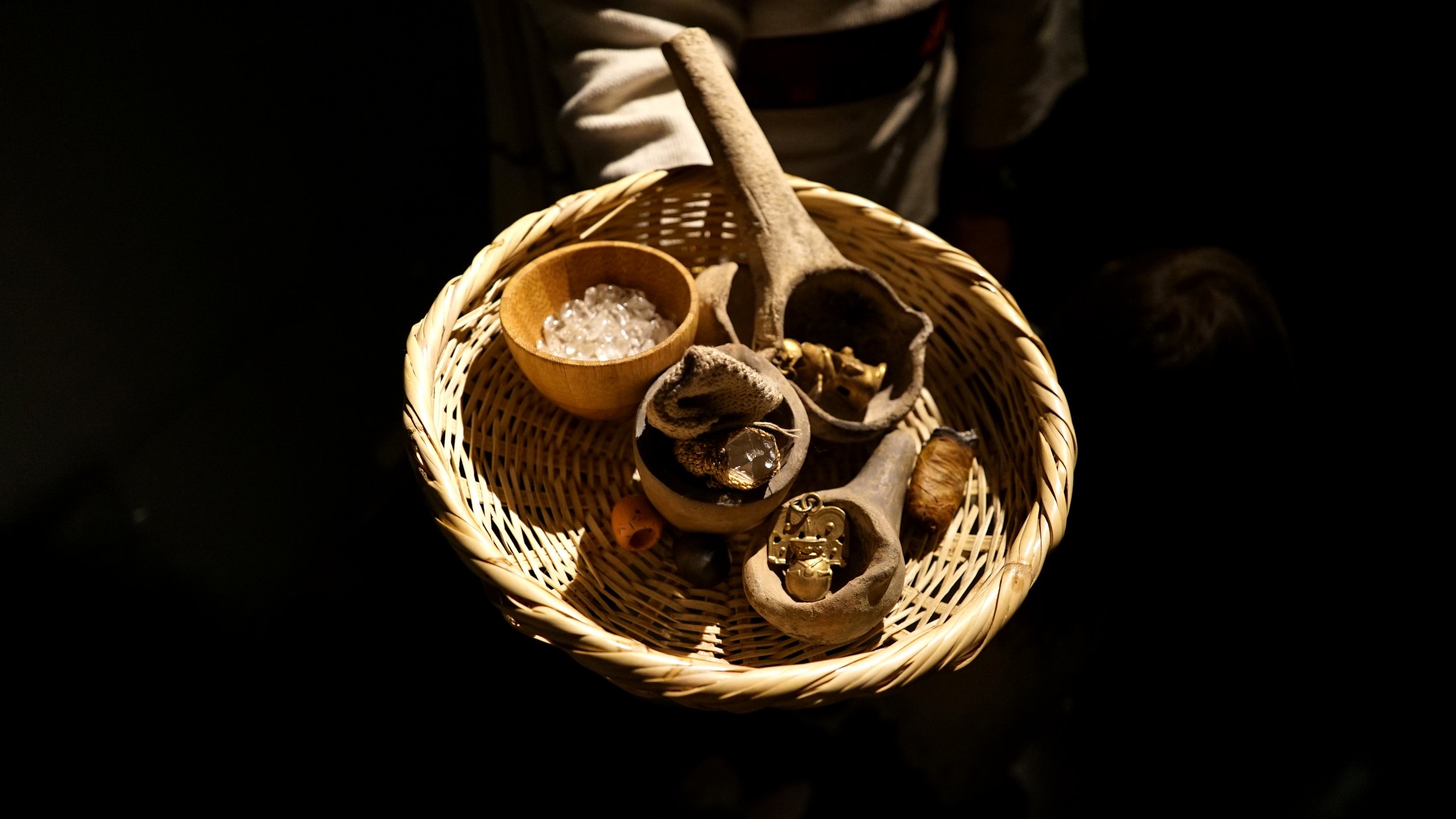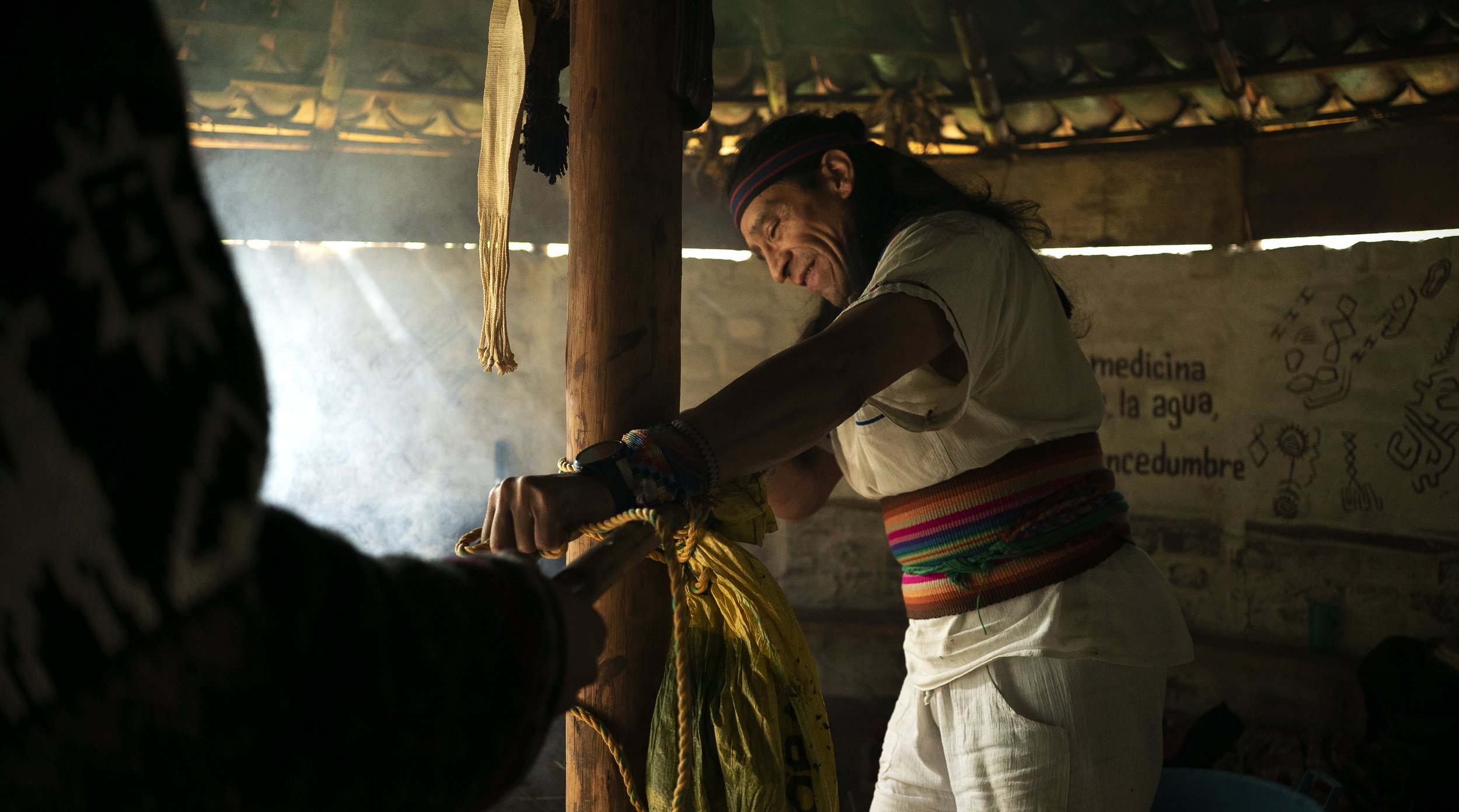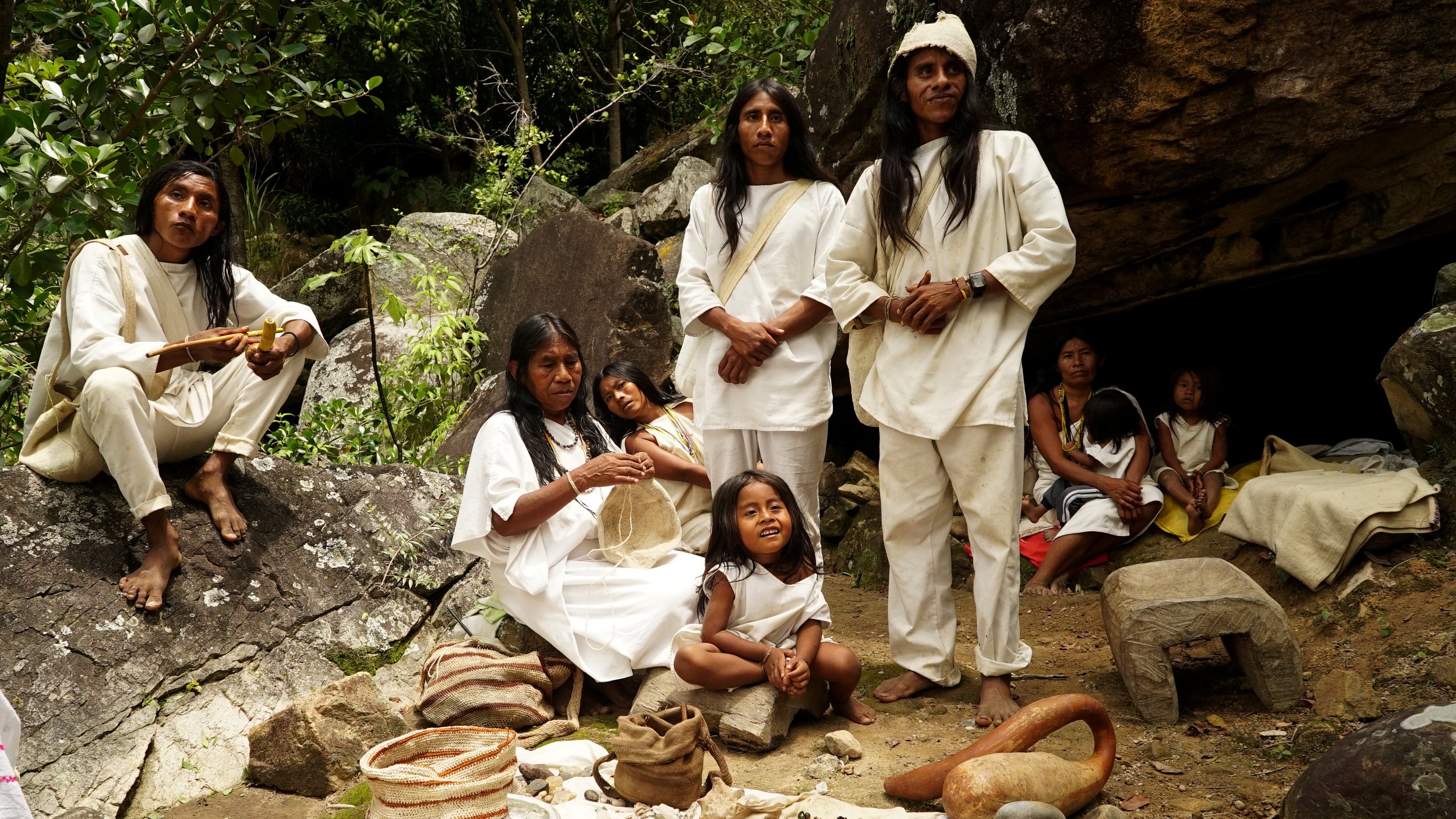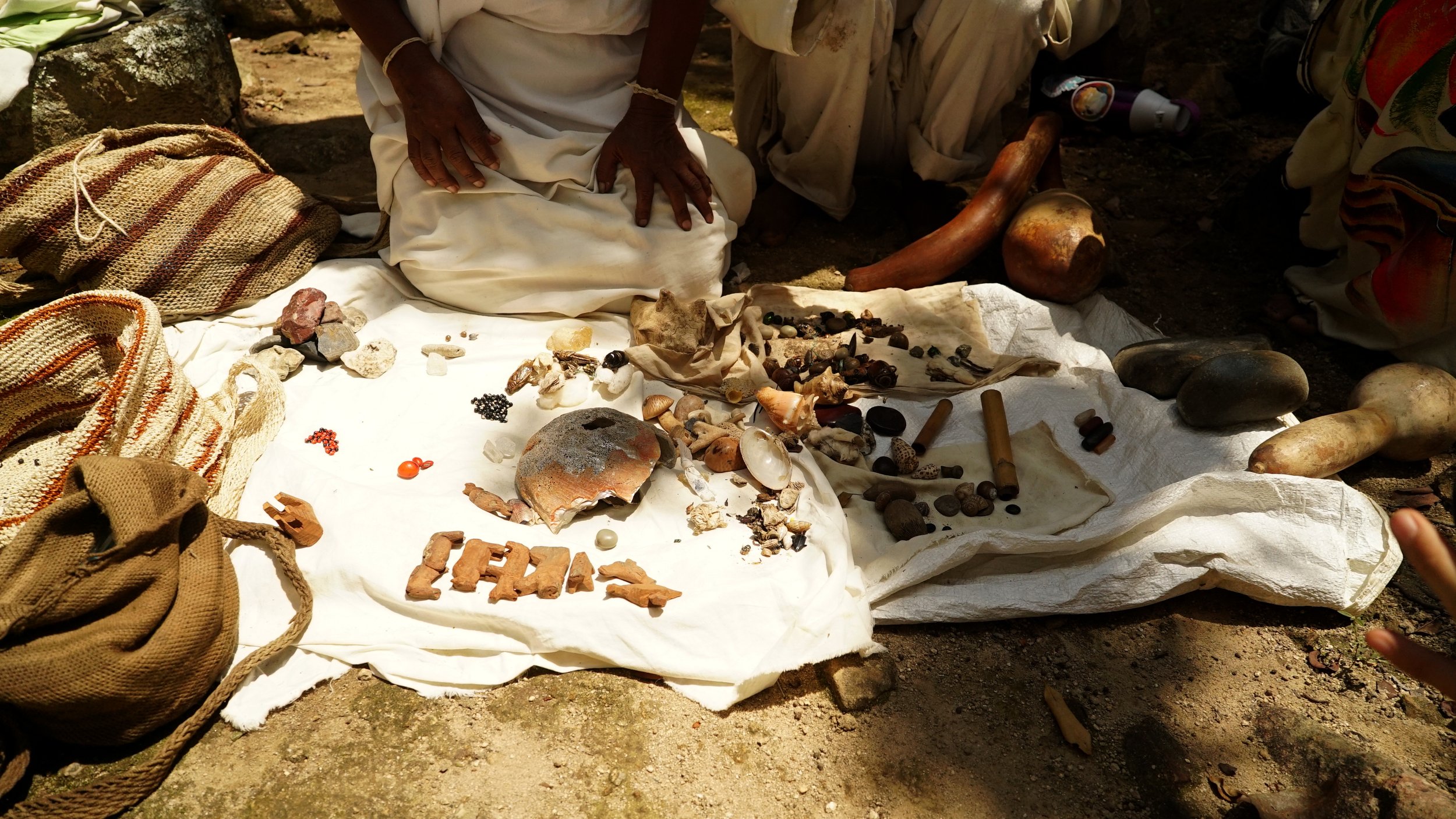








The Muysca embrace constant connection to heal Mother Earth
WORDS BY JESS CZARNECKI
IMAGES BY MARIANA RIVERA-URIBE
“The word “Muysca” means people, and everything is Muysca. Tree people, sky people, river people; all are beings that must be treated with the same respect one treats themselves.”
Imagine everything we encountered was imbued with intention. What is the intention behind eating? When our bodies tell us to eat, we might not give pause to consider our hopeful outcomes: to nourish, energize, or perhaps satisfy a craving.
In Muysca culture (“muisca” in Spanish), everything has meaning and is treated with care and gratitude from origin. Seeds, for example, are cleansed spiritually, given thanks, and infused with intention verbally or through song. This process not only cleanses the seed and eventual plant, but the being who will receive the food, clothing or medicine, as well as the spirits and earth from whom they came.
This process of gratitude and care breeds relationships. When we feel grateful towards another human being, we are less likely to harm them. Moreover, this shifting mindset breeds respect and care for the land, which has been forced to produce what she is not naturally meant to, leading us to environmental collapse. For the Muysca, there is no distinction between human and non-human beings. The word “Muysca” means people, and everything is Muysca. Tree people, sky people, river people; all are beings that must be treated with the same respect one treats themselves.
For the Muysca, everything is people: “earth people,” “river people,” tree people” and all living beings who we share the planet with. Understanding this is the first step to re-learning the teachings that have been lost during centuries of separation from our true selves. Therefore, the process of freeing the mind is inseparable from that of freeing the land from the oppression and exploitation it has been suffering for years.
Both Muysca and Wiwa communities are ancient Indigenous civilizations native to the country known today as Colombia. Like most Indigenous populations around the world, their histories are marked by a story of violence, displacement, and an attempt to take over their gold and lands in the name of colonial, patriarchal, capitalist systems that pervade much of the world today. These systems have spread like a disease in the region since the 15th century.
Muysca territories were sought after by ill-advised Spanish colonizers in search of the mythical El Dorado (city of gold), believing there was a hidden reserve from which the Muysca extracted the substance for their creations. Though the Muysca made innumerable intricate gilded artifacts, they were rich in spiritual value rather than monetary and were created as offerings.
Gold displayed in the Museo Del Oro in Bogotá. “We Muysca are people, new people, seed people, gold that blossoms from the womb of Mother Earth. We are seeds of gold, we are the true offering to Mother Earth. Our thoughts, words, actions and intentions are the seeds we share and these will give birth to the fruits we as humanity feed on and become.”
“A community of Muysca is fighting in the most revolutionary way: by rejecting colonial and capitalist systems in favour of practicing their traditions and reclaiming their connection with nature.”
“Gold is the ovum of Mother Earth,” says Buntkua, the leader of the Fowe Muysca community, which is based a few hours away from so-called Bogotá, Colombia’s capital. In the lush, misty mountains of Chingaza National Park near Bogotá lie the Páramo de Chingaza—a critical ecosystem only found in the Andes mountain range. According to the Muysca, the páramo is the uterus of Mother Earth, and they make gold offerings to the lagoon within it to ensure the process of life continues. “We offer the gold to the lagoon to ensure the ovulation process of Mother Earth. The gold ovum connects with the seed of light which enters into the lagoon through the rays of the sun. And we say that in that moment, the process of life begins.”
The offering of gold also represents the offering of ourselves to Mother Earth, and the Muysca partake in a nine-day ceremony to cleanse and refine both the gold and their bodies, minds, and spirits before their journey to the lagoon.
Every year, for nine days, during the spring equinox, the Fowe Muysca community celebrate/honour the ceremony of Nya, the Spirit of Gold. For them, the value of the gold does not lie in the physical plane or the material properties of this precious mineral, but in the sacredness of the spirit which lies behind it.
“The offering of gold also represents the offering of ourselves to Mother Earth...”
A stark contrast to the Muysca’s respect for gold and this sacred lagoon, colonizers went so far as to drain lakes in search of El Dorado and the gold artifacts Muysca peoples had offered to its waters. This is just one instance of the cultural pillaging and erasure that would unfold in the centuries to come.
Indigenous peoples in Colombia and all over the colonized world have fought against governments, destructive corporations, and settlers to protect and reclaim their land—a battle not often won. But now, a community of Muysca is fighting in the most revolutionary way: by rejecting colonial and capitalist systems in favour of practicing their traditions and reclaiming their connection with nature.
“We care for the origin of everything in the emptiness of Bagüe, primordial Mother Grandmother. Sacred mind-place where everything is gestated, where everything is created. In the honey of the Grandfather Tobacco we carry the memory of the lineage, we share the same universal blood.”
“To decolonize the land, say the Muysca, you must decolonize the mind. The Muysca have a process for returning to natural ways of being: ‘Aka Muysca, Zuhuskansuka Aba,’ meaning ‘the ones who return home (to the seed, to origin).’”
“We are taught to make ourselves bigger and richer, instead of realizing we already have everything we need,” says Mariana Rivera-Uribe. As a Revolutionary Storyteller Grant recipient, Mariana is collaborating with the Muysca and Wiwa community to share their story. “If we want to save ourselves and save the planet, we need to question these teachings which stem from colonialism.”
To decolonize the land, say the Muysca, you must decolonize the mind. The Muysca have a process for returning to natural ways of being: “Aka Muysca, Zuhuskansuka Aba,” meaning “the ones who return home (to the seed, to origin).” Aka Muysca, Zuhuskansuka Aba is only possible through an alternative education system which generates an understanding of our inherent connection with all of Earth’s beings and teaches how to maintain a constant dialogue with nature to best protect and respect the land.
This process permeates all aspects of daily life: cultivating food native to the land, the use of medicinal plants in ceremonies and offerings, and perpetual intentionality and expressions of gratitude. Young generations are also initiated to become chikys: interpreters between nature and humans. Intergenerational knowledge sharing is crucial to strengthening social and environmental stability, as it calls back the wisdom of those who originally inhabited the land, lost throughout centuries of separation from our origins.
Isaías, a young Muysca boy hugs his horse, Chíe, after a ride. Children are a fundamental part of the Fowe Muysca community as they are conceived as the purest seeds who can re-learn the ancestral Muysca knowledge.
“We are taught to make ourselves bigger and richer, instead of realizing we already have everything we need.”
The Muysca have been working alongside other Indigenous communities such as the Wiwa, Kogui and Arhuaco from the Sierra Nevada de Santa Marta to join their efforts in liberating the land from privatization and extractivism, which has led these ancestral and sacred lands to become dry, eroded and dead. Together, for over ten years, the Wiwa and Muysca communities have been working together to redefine what it means to be native, beyond frontiers and modern concepts which strive to segregate humanity.
An example of the impacts of erosion on a once lush and fertile landscape: the Sierra Nevada de Santa Marta
“The Muysca say, ‘What’s inside is outside.’ So whatever you are doing—to yourself, to your body, to your mind, to everything that surrounds you—affects what happens outside.”
Mariana became connected with the Muysca community through Buntkua, who she met over a decade ago while volunteering for his former NGO, Colectivo Talanquera. The stars aligned when they happened to meet through friends years later. When they reunited, Buntkua was grateful but not at all surprised. “He said to me, very calmly and seriously, ‘If we are meeting again, it is because there is something still pending between us,’” recalls Mariana.
By creating and collaborating with the Fowe Muysca and Wiwa communities to illuminate the revolutionary ways of living in harmony with the Earth, Mariana hopes to inspire the same respect and reciprocity for the land in others, and for themselves. “The Muysca say, ‘What’s inside is outside.’ So whatever you are doing—to yourself, to your body, to your mind, to everything that surrounds you—affects what happens outside.”
For nine days, during the winter equinox, the elders visit nine sacred lagoons, where they offer spiritual and material offerings with the purpose of restoring and maintaining the balance of the waters of Mother Earth. The messages given here are carried out through the whole planet through evaporation, rain and the rivers, which are all interconnected.
The Wiwa are one of the four descendants of the ancestral Tairona, who inhabited the north of Colombia, mainly on the coast of the country. After colonization, many Tairona were either assassinated or forced to move to the highest parts of the Sierra Nevada de Santa Marta mountain range to survive, where they split into four groups still present today: Arhuaco, Kogui, Kankuamos and Wiwa. The Wiwa recognize themselves as Damanas, which means “the protectors of Mother Nature,” and they devote their days to the spiritual practices which are aimed at the protection and safeguarding of the Earth and all its beings.
Currently, the Wiwa communities live in small villages composed of family members, along the east side of the Sierra Nevada de Santa Marta, in between privatized lands dominated by cattle and agriculture—lands which used to be tropical rainforests and places of ceremonial practices.
The Lorenzos, a family in the Wiwa community, outside their home.
These lands are inaccessible for them today and have become eroded, dry memories of what was once a place of peace, abundance and coexistence between people and Nature. What was once a thriving tropical rainforest, filled with trees and sacred ceremonial spaces, is now a parched, eroded landscape. Due to the privatization of the land and the plans of the government to “make land productive,” farmers introduced cattle and goats into the Sierra Nevada de Santa Marta, resulting in the land becoming increasingly arid and infertile. It is common to see fragmented cracks in the landscape, and the mighty rivers, once abundant and perennial, have become small seasonal streams.
A large crack, dramatically pictured here, shows the impact of erosion on a once fertile and lush landscape.
The absence of forests has disrupted the natural rain cycles, intensifying droughts in the mountains, and making it more and more difficult for the Indigenous communities to cultivate their food and endure in their own territories. Many lands have been looted, their treasures now sold as amulets and souvenirs in markets; this has separated Indigenous people from the elements that are a fundamental part of their identity and culture.
Mariana’s Revolutionary Storyteller project—along with the work of students from the last PWB Storytelling School in Colombia which took place in the Wiwa village of Rongoy—seeks to raise support for an ongoing campaign. This project, which has been set between the Muysca and Wiwa communities, aims to reclaim 20 hectares of land in the Sierra Nevada de Santa Marta, in the north of Colombia near Rongoy. The project also supports the construction of an ancestral pedagogy/education centre, where native communities and people from all around the world can come together and learn about Indigenous cultures, traditions, cosmologies, ancestral permaculture, reforestation—ultimately the caring and connection with Mother Earth.
The lush green landscape of the Sierra Nevada de Santa Marta. What was once a thriving tropical rainforest is now a parched, eroded landscape.
The Santa Marta mountain range, known as the “Heart of Mother Earth” by several Indigenous groups, is considered a powerful and energetic centre which is fundamental for the balance of the whole planet. Therefore, it is not only the responsibility of the Wiwa to protect it, but a collective obligation of all of us who inhabit the Earth.
This revolutionary idea of Indigenous communities coming together as one is the result of a collective effort which aims to protect the land and waters of the Earth as one, independently of the history, lineage and individual beliefs of each community. Both the Muysca and the Wiwa believe that, by working together, they will have a bigger chance to recover their lands and ultimately protect Mother Earth from the industrial projects that continue to violate her freedom.
Buntkua Yari Maku, leader of the Fowe Muysca community, spent over 10 years living and learning from the Wiwa and Arhuaco communities in the Sierra Nevada.
“The definition of revolutionary is going inside yourself and questioning everything you’ve been told you are meant to want or need.”
Although far from their goal, progress has been made. In 2021, the Muysca community built the Chunzua, or “sacred house of governance,” with the help of elders from different Indigenous communities in the country and supporters from all over the world. This space is where matters are discussed around an eternal fire, which guides what can and cannot be done in the community. “All decisions are based on the “Law of Origin” and on the fundamentals of the “new humanity.” The Law of Origin deems that all actions should align with the natural rhythms and processes of the Earth. The new humanity is one that respects and honours the land and water, and that guards the spirit and memory of the elders and ancestors to maintain a legacy of protecting Mother Earth and living in harmony with all beings.
As we propel towards environmental destruction, the idea of community, that we are all one, connected with everything under the sky, is a mindset we must adopt to build relationships with the Earth and prevent its demise.
This is a “chunswa,” or “people house”, home of the sacred fire, the house of the Sun, which fosters the rebirth of an ancient new humanity.
“The most valuable thing is the caring of life, the caring of relationships, and the caring of this magical Mother Earth.”
“I think the definition of revolutionary is going inside yourself and questioning everything you’ve been told you are meant to want or need,” says Mariana.
The practice of decolonizing the mind is not limited to those with Indigenous roots. We are all Muysca planetarios (people of the planet), and we all have a responsibility to take care of our fellow beings. Even small actions like thanking the food we eat and acknowledging its origins, being mindful of our consumption and waste, and expressing gratitude to the air we breathe, the trees which shade us, and the water that hydrates and cleanses, go a long way towards building and maintaining our relationship with—and respect for—Mother Earth.
Every year for nine days, several Muysca communities come together to lead the "Correr la Tierra" (Earth Run), which is an ancestral ceremony. Before the winter equinox, the elders run up to 60 kilometres a day to visit nine sacred lagoons, where they give spiritual and material offerings to the water to maintain and restore the balance of Mother Earth’s waters.
The Muysca and the Wiwa—like many Indigenous peoples around the world—continue to act in revolutionary ways, rejecting capitalist, patriarchal systems in favour of maintaining mindsets of abundance over scarcity; acting in reciprocity and only taking what is offered, and teaching younger generations to respect rather than exploit. In Buntkua’s words, “The most valuable thing is the caring of life, the caring of relationships, and the caring of this magical Mother Earth.”
This story was created with the support of Aesop and our Revolutionary Storyteller Grant. Support Indigenous communities in the Sierra Nevada to protect their land and safeguard their culture by building an ancestral education centre in Colombia.


















